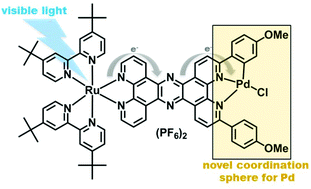Tuning of photocatalytic activity by creating a tridentate coordination sphere for palladium†
Abstract
The synthesis and characterisation of an asymmetric potential bridging ligand bmptpphz (bmptpphz = 2,17-bis(4-methoxyphenyl)tetrapyrido[3,2-a:2′,3′-c:3′′,2′′-h:2′′′,3′′′-j] phenazine) is presented. This ligand contains a 1,10-phenanthroline (phen) and a 2,9-disubstituted phen sphere and possesses a strong absorbance in the visible. Facile coordination of the phen sphere to a Ru(tbbpy)2 core leads to Ru(bmptpphz) ([(tbbpy)2Ru(bmptpphz)](PF6)2; tbbpy = 4,4′-di-tert-butyl-2,2′-bipyridine). UV-vis, emission, resonance Raman and theoretical investigations show that this complex possesses all properties associated with a Ru(tpphz) ([(tbbpy)2Ru(tpphz)](PF6)2; tpphz = tetrapyrido[3,2-a:2′,3′-c:3′′,2′′-h:2′′′,3′′′-j] phenazine) moiety and that the ligand based absorbances in the vis-part also populate an MLCT like state. The coordination of a Pd-core in the new 2,9-disubstituted phen sphere is possible, leading to a cyclometallation. The tridentate complexation leads to changes in the UV-vis and emission behaviour. Furthermore, the stability of the Pd-coordination is significantly enhanced if compared to the unsubstituted Ru(tpphz). Ru(bmptpphz)PdCl proved to be an active photocatalyst for H2 evolution, albeit with lower activity than the mother compound Ru(tpphz)PdCl2.


 Please wait while we load your content...
Please wait while we load your content...